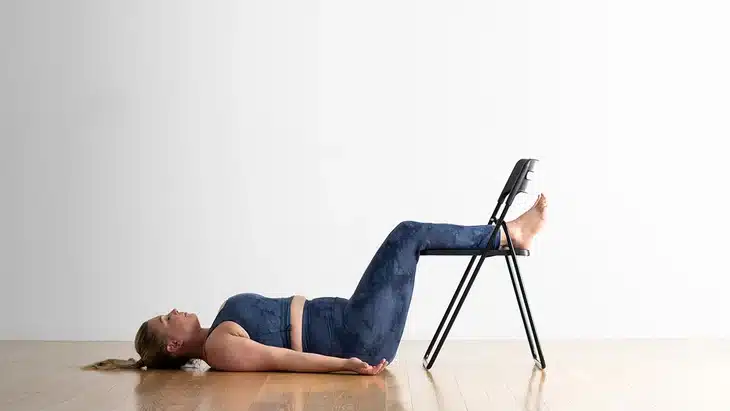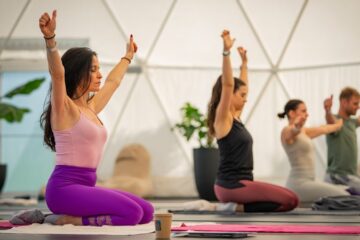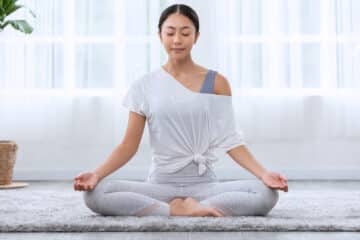In the fast-paced world we inhabit, moments of rest and rejuvenation are precious commodities. Legs Up the Wall Pose, also known as Viparita Karani, offers a sanctuary of relaxation amidst the chaos—a simple yet profoundly beneficial yoga posture that invites practitioners to surrender to stillness and renewal.
By reclining with their legs elevated against a wall, individuals can experience a myriad of physical, mental, and emotional benefits that restore balance and vitality to body and mind.
Understanding Legs Up the Wall Pose (Viparita Karani):
Legs Up the Wall Pose is a gentle inversion where practitioners lie on their backs with their legs extended upward against a wall, forming a 90-degree angle with their torso.
This rejuvenating posture allows gravity to work in favor of the body, promoting circulation, relaxation, and release. Legs Up the Wall is accessible to practitioners of all levels and can be practiced anytime, anywhere, making it an invaluable tool for stress relief and self-care.
How to Practice Legs Up the Wall Pose:
- Find Your Space: Locate a clear wall space in a quiet, comfortable area where you can lie down without interruption.
- Prepare Your Props: Gather any props you may need, such as a folded blanket or bolster, to support your lower back and hips.
- Sit Close to the Wall: Sit sideways with one hip touching the wall and your knees bent. Gently pivot your body and extend your legs upward, allowing your back to rest on the floor and your legs to lean against the wall.
- Support Your Lower Back: If desired, place a folded blanket or bolster under your hips for added support and comfort.
- Adjust Your Position: Find a position where your legs are comfortably straight and your back is relaxed against the floor. Allow your arms to rest by your sides, palms facing up.
- Relax and Breathe: Close your eyes and take slow, deep breaths, allowing your body to surrender to the support of the floor and the wall. With each inhale, feel your abdomen gently rise, and with each exhale, feel the tension melting away from your body.
- Hold and Release: Remain in the pose for 5-15 minutes, or longer if desired, enjoying the deep relaxation and rejuvenation it brings. When you’re ready to release, gently bend your knees and roll onto one side before slowly coming up to a seated position.
Benefits of Legs Up the Wall Pose:
- Improves Circulation: Elevating the legs promotes venous return, allowing blood and lymphatic fluid to flow more freely throughout the body and reducing swelling and fatigue in the legs.
- Relieves Stress and Anxiety: Legs Up the Wall Pose has a calming effect on the nervous system, helping to reduce stress, anxiety, and tension in the body and mind.
- Soothes the Mind: The gentle inversion of this pose encourages a shift in perspective, promoting mental clarity, relaxation, and a sense of inner peace.
- Relaxes the Muscles: By allowing the muscles of the legs and lower back to relax fully, Legs Up the Wall Pose can alleviate muscle tension and soreness, promoting overall physical comfort and well-being.
Precautions and Modifications:
- Neck Support: If you have any discomfort in your neck, place a folded blanket or small pillow under your head for extra support.
- Lower Back Sensitivity: If you experience sensitivity in your lower back, adjust the height and placement of the props to find a comfortable position.
- Pregnancy: Pregnant individuals can practice Legs Up the Wall Pose with caution, using additional support as needed and avoiding deep pressure on the abdomen.
Conclusion
Legs Up the Wall Pose offers a sanctuary of relaxation and renewal for body, mind, and spirit. By surrendering to the support of the wall and allowing the body to rest and restore, practitioners can experience a profound sense of well-being and balance.
Whether you’re seeking relief from stress, improved circulation, or simply a moment of quiet introspection, Legs Up the Wall Pose invites you to embrace relaxation and renewal, one breath at a time.




